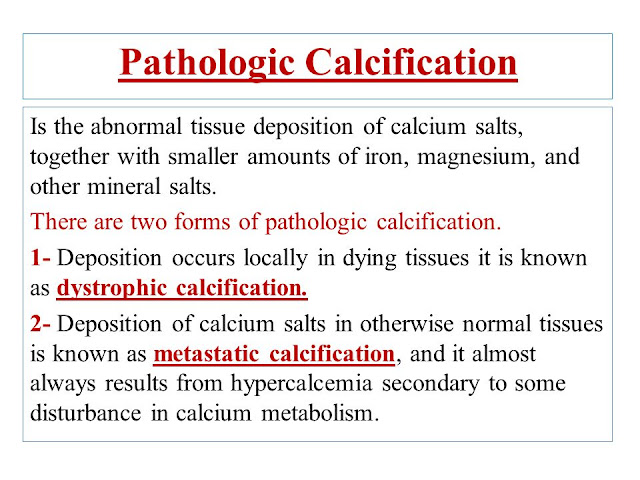Pathologic calcification, a common process in a wide variety of disease states, is the result of an abnormal deposition of calcium salts, together with smaller amounts of iron, magnesium, and other minerals.
PATHOLOGIC CALCIFICATION
It can occur in two ways.
Atrophic calcification. In this form, calcium metabolism is normal but it is deposited in damaged or necrotic tissues, such as areas of necrosis of any kind. It is almost ubiquitous in arterial lesions of advanced atherosclerosis. Although dystrophic calcification may be an incidental finding indicating insignificant cell damage in the past, it may also be a cause of organ dysfunction. For example, calcification can occur with age or damage to the heart valves, resulting in severe impairment of valve movement. Dystrophic calcification of the aortic valve is a major cause of aortic stenosis in the elderly.
Dystrophic calcification is initiated by the extracellular deposition of crystalline calcium phosphate on membrane-bound vesicles that may be derived from damaged cells, or the intracellular deposition of calcium on the mitochondria of dying cells. Extracellular calcium is thought to be concentrated in vesicles due to its affinity with membrane phospholipids, whereas phosphate accumulates by the action of membrane-bound phosphatases. The crystals then expand to form larger deposits.
• Metastatic calcification. This module is linked to extra football and can be in natural tissues. The main reason for hyperclasmia (1) increases the secretion of triangles hormone, due to hormonal parathyroid production from primary parathiroid tumor or other fatal tumors; (2) Bone degradation due to the effect of quick business (for example (3) vitamin D disorder, which includes vitamin D toxicity and surconosis (in which macrophages activate a precursor vitamin); And (4) insufficient kidneys, In which the immersion of phosphate leads to the secondary hyperpethler.
Book Refrence: Robbins (tenth edition)

